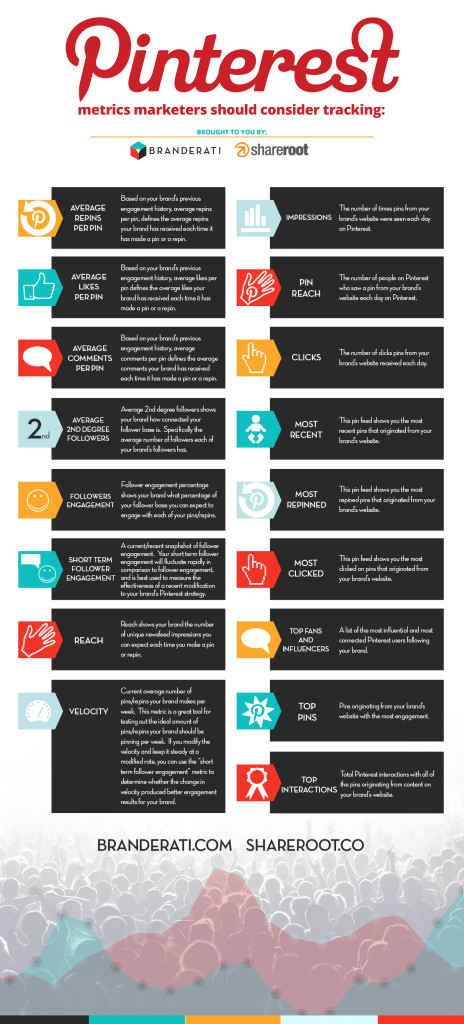On the surface, Pinterest metrics seem simple, but underneath they are actually a bit confusing. This follow up article to our Ultimate Guide for Pinterest should help you gain a deeper understanding of Pinterest metrics and provide tips on effectively engaging with, and growing your follower base.

Like Twitter, Pinterest allows you to post content to your feed that will appear in the newsfeed of your followers. The catch is unlike Twitter, you actually have multiple feeds that you can post to in the form of boards. This in of itself is not hard to understand, think of it as categorizing the content you post. The confusing part comes into play when you look deeper and realize each board has its own set of followers (see this blog post by a Pinterest developer on the inner workings of the follower graph). This means that any one of your followers may only be following a subset of your boards.
The key is to recognize that this happens, because it may have huge implications to how you choose to engage with your followers on Pinterest. For instance, you may have 1,000 unique followers in total but it is entirely possible to have 900 followers on one board and only 300 on your other boards. What this means is that to reach the greatest number of followers you’ll need post to that one board only. So if you’re about to announce a promotion or anything that is of importance on Pinterest, you should be sure to check which board will get you the greatest reach and theme your pin accordingly.
The list below highlights the key metrics you should familiarize yourself with. The full list of Pinterest metrics you should track is covered by this infographic.
Unique Followers – This is the total number of unique followers a Pinterest page has regardless of how many boards each follower is following. This number is the main follower metric reported near the top of a Pinterest page.
Page Followers – The number of users following all boards on a Pinterest page. These followers follow all boards and all boards created in the future. They are obtained when a user hits the Follow All button.
Board Followers – The number of followers for a given board. This metric is provided near the top of each board page.
Average Board Followers – The average number of followers all of the boards on a Pinterest page have.
Follower Saturation – Ratio of average board followers to page followers. The closer this number is to 100%, the less you need to strategize about which board to pin content to, and the more followers you will reach with each pin.
How can one improve follower saturation?
Within the Pinterest Environment
Because follower saturation is caused by a large portion of your brands’ followers being board followers rather than page followers, leveraging your most popular boards as promotional tools is the best free tool at your disposal. In order to leverage your boards with the highest board follower counts, you have a handful of options:
- Point your pins (URLS) on the popular boards to your boards on the less popular boards.
- Create pins on your popular board that thematically intersect that board and one of your less popular boards, and mention the board you are talking about in the comment section of those pins.
- Rearrange your Pinterest boards so that the least popular boards are at the top of your board list. Feel free to keep this order in a consistent cycle.
- Pin more often from your less popular boards.
- Invite followers of your popular board to follow your Pinterest page by mentioning a reason for the users to follow your entire page within the board title of the popular board/s.
- Repin related popular pins from Pinterest’s categorical feed to your less popular boards.
Outside of Pinterest
Most follow buttons that appear organically on Pinterest are for specific boards. This means that most of your page followers will likely be driven from off-site links/properties. Getting more page followers will improve your saturation levels. This involves reaching your fans in the typical cross-promotional ways: through your existing channels of Twitter, Facebook, email, or your blog. It can also be useful to integrate the Pinterest follow button on your website to drive users to your Pinterest page.
Promotions and Campaigns
Paid campaigns, such as contests or paid media, can also help increase your chances of converting more page followers. Companies such as Tailwind, ShareRoot, Piqora, and Reachli, can help your brand with Pinterest analytics, contests, and advertising. ShareRoot, a company specializing in paid Pinterest promotions, has put together a several free tools that you may utilize to help with your cross-promotional efforts. Their ToolSet includes a free Pinterest tab for Facebook, a cross-promotional pin creator, a board cover creator, a follower analysis tool, and a pin velocity analysis tool. Each of these tools can help your brand increase its follower saturation percentage, and convert its board followers into page followers.
Pinterest also recently announced that it will be testing out promoted pins. Even though promoted pins are not yet available for purchase, you can keep a close eye on Pinterest’s blog for any updates in this area.
Originally posted in Fast Company
